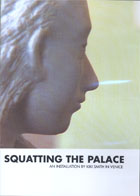
Squatting the Palace: An Installation by Kiki Smith in Venice 2006
Distributed by Microcinema International/Microcinema DVD, 1636 Bush St., Suite #2, SF, CA 94109; 415-447-9750
Produced by Edgar B. Howard / Checkerboard Film Foundation, Inc.
Directed by Vivien Bittencourt and Vincent Katz
DVD, color, 45 min.
Sr. High - Adult
Art, Biography, Museums, Women's Studies
Date Entered: 04/27/2010
Reviewed by Louise Greene, Art Library, University of Maryland, College ParkTo watch artist Kiki Smith at work is as fascinating in its own way as the art she is creating. In this all-to-brief documentary, the internationally-known artist is caught up in final preparations for an exhibition in Venice, Italy, and anyone with an interest in the creative process will not want to miss this slice-of-life experience.
At her home studio in New York City, Smith is in perpetual motion—dabbling, it seems, in the variety of media that comprise an intriguingly eclectic assemblage of works in every stage of completion. While at the same time dealing with assorted assistants, tradesmen and callers, she muses about her spartan early life as the daughter of an artist and an opera singer. Ever animated and engaged, Smith somehow seems calm at the center of this vortex.
Against the serene backdrop of Venice, the last-minute chaos begins in earnest as walls are painted, works are placed, moved and placed again, while all manner of paraphernalia arrives at the museum from all quadrants by gondola, water taxi and hand truck.
At last, visitors to the exhibition, “Homespun Tales: Stories of Domestic Occupation” part of the 2005 Venice Biennale, begin to wander through the airy rooms of the Fondazione Querini Stampalia, once a gracious private residence, now inhabited by Smith’s spare, enigmatic forms and figures—and the legendary Venetian light.
Squatting the Palace is not about celebrity; it is personal, down-to-earth, and accessible. Smith’s work seems all the more powerful and eloquent for the almost workaday persistence with which she draws it out of herself. This revealing film about one artist’s way of working quietly helps to bring “Art” within reach of the rest of us. It is highly recommended for libraries and programs with collections in art, and more broadly, collections in general.